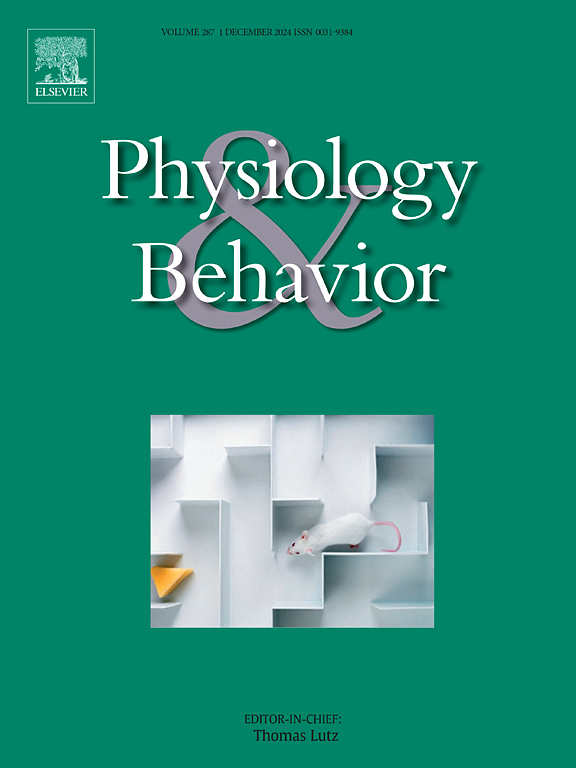Role of CTRP14/C1QL1 in motor coordination and learning across the lifespan
IF 2.4
3区 医学
Q2 BEHAVIORAL SCIENCES
引用次数: 0
Abstract
C1q/TNF-related protein 14 (CTRP14), also known as C1q-like 1 (C1QL1), is a synaptic protein predominantly expressed in the brain. It plays a critical role in the formation and maintenance of the climbing fiber-Purkinje cell synapses, ensuring that only one single winning climbing fiber from the inferior olivary neuron synapses with the proximal dendrites of Purkinje cells during the early postnatal period. Loss of CTRP14/C1QL1 results in incomplete elimination of supernumerary climbing fibers, leading to multiple persistent climbing fibers synapsing with the Purkinje cells. While this deficit impairs oculomotor learning in adult mice, the impact of CTRP14 deficiency on motor function throughout adulthood has not been examined. Here, we conduct behavioral tests on a constitutive Ctrp14 knockout (KO) mouse model to determine whether CTRP14 is required for motor learning and function in mice across the lifespan. We show that CTRP14 deficiency does not affect grip strength, nor sprint and endurance running, in young and old mice of either sex. We performed accelerated rotarod tests on mice at 6, 12, and 18 months old to assess motor coordination and learning. No significant differences were observed between WT and Ctrp14-KO mice of either sex across the lifespan. Lastly, we performed complex running wheel tests to detect latent motor deficits and found that aged Ctrp14-KO mice have intact motor skills. Despite some limitations of the study, our data suggest that CTRP14 is dispensable for gross motor skills, coordination, and learning throughout adulthood based on the specific tests performed.
CTRP14/C1QL1在运动协调和学习中的作用。
C1q/ tnf相关蛋白14 (CTRP14),也称为C1q样1 (C1QL1),是一种主要在大脑中表达的突触蛋白。它在攀爬纤维-浦肯野细胞突触的形成和维持中起着至关重要的作用,确保在出生后早期浦肯野细胞近端树突的下橄榄神经元突触中只有一条攀爬纤维获胜。CTRP14/C1QL1的缺失导致多余的攀爬纤维不完全消除,导致多个持久的攀爬纤维与浦肯野细胞突触。虽然这种缺陷损害了成年小鼠的动眼肌学习,但尚未研究CTRP14缺陷对整个成年期运动功能的影响。在这里,我们对组成型Ctrp14敲除(KO)小鼠模型进行了行为测试,以确定Ctrp14在小鼠的整个生命周期中是否需要运动学习和功能。我们发现CTRP14缺乏不影响握力,也不影响短跑和耐力跑,无论是年轻的还是年老的雌雄老鼠。我们对6个月、12个月和18个月大的小鼠进行了加速旋转测试,以评估运动协调和学习能力。无论性别,WT和Ctrp14-KO小鼠在整个寿命期间均未观察到显著差异。最后,我们进行了复杂的跑步轮试验来检测潜在的运动缺陷,发现年老的Ctrp14-KO小鼠具有完整的运动技能。尽管该研究存在一些局限性,但我们的数据表明,基于所进行的具体测试,CTRP14对整个成年期的大肌肉运动技能、协调和学习是不可或缺的。
本文章由计算机程序翻译,如有差异,请以英文原文为准。
求助全文
约1分钟内获得全文
求助全文
来源期刊

Physiology & Behavior
医学-行为科学
CiteScore
5.70
自引率
3.40%
发文量
274
审稿时长
47 days
期刊介绍:
Physiology & Behavior is aimed at the causal physiological mechanisms of behavior and its modulation by environmental factors. The journal invites original reports in the broad area of behavioral and cognitive neuroscience, in which at least one variable is physiological and the primary emphasis and theoretical context are behavioral. The range of subjects includes behavioral neuroendocrinology, psychoneuroimmunology, learning and memory, ingestion, social behavior, and studies related to the mechanisms of psychopathology. Contemporary reviews and theoretical articles are welcomed and the Editors invite such proposals from interested authors.
 求助内容:
求助内容: 应助结果提醒方式:
应助结果提醒方式:


